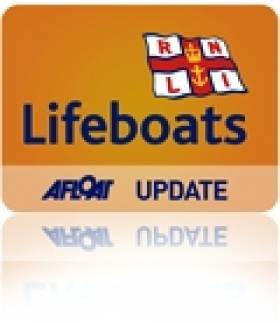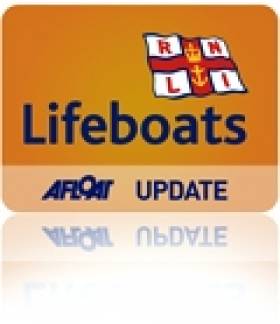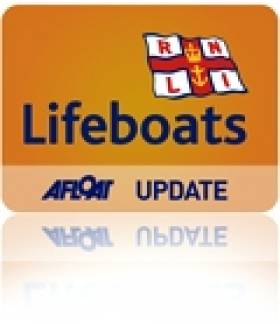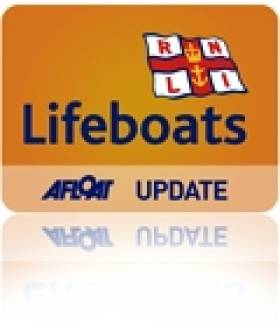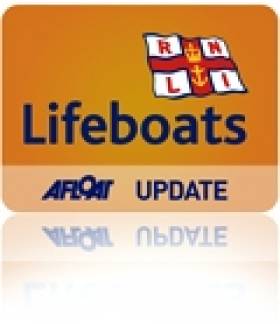Displaying items by tag: Lifeboat
Irish Lifeboats Launched Over 900 Times in 2012
#RNLI - Irish lifeboats from the Royal National Lifeboat Institution (RNLI) launched 939 times in 2012, bringing 1,041 people to safety.
The figures are being released by the charity following returns of service from all 44 lifeboat stations in Ireland. The figures also show that the majority of callouts were to pleasure craft, which accounted for 482 of the callouts, while launches to fishing vessels were 115.
Dun Laoghaire RNLI brought the highest number of people to safety with 76 individuals rescued by their volunteer lifeboat crews during 46 callouts. They were followed by Kilmore Quay RNLI in Co Wexford, who brought 71 people to safety on 29 callouts.
The busiest RNLI lifeboat station in Ireland last year was Bangor in Co Down, which launched 53 times and rescued 53 people. Over half of their callouts were carried out in the hours of darkness.
Other busy stations include Crosshaven RNLI in Cork where lifeboat crews launched their inshore lifeboat 42 times and rescued 31 people. Baltimore RNLI – who, along with Kilmore Quay RNLI, operate Ireland's two Tamar class lifeboats, the most technologically advanced lifeboat in the Irish fleet – launched their two lifeboats 41 times, rescuing 41 people. They also carried out almost three quarters of their callouts in the hours of darkness. The second Dublin all weather lifeboat station, based in Howth, launched 40 times and rescued 48 people.
The RNLI's newest lifeboat station at Coosan Point, Athlone on Lough Ree, which is currently on a one year trial from last June, had a busy first six months launching 14 times and bringing 18 people to safety.
The charity's lifeboat crews also had 122 callouts to people classed as ´ashore`. This figure incorporates launches to people who are ill or injured on an island, cliff or the shoreline, where access by lifeboat is the fastest or safest way to reach the casualty. It also includes medical evacuations from the islands off the coast of Ireland by lifeboat, which is a vital part of the service given by lifeboat stations such as Arranmore Island in Co Donegal and the Aran Islands off Co Galway.
In comparison with the 2011 statistics, 2012 saw a slight drop in lifeboat launches from 983 to 939 but a rise in people rescued from 906 to 1,041, an increase of 135 in the twelve month period.
Martyn Smith, RNLI operations manager for Ireland, says: 'The figures show that our volunteers dedicate a huge amount of their time to saving lives at sea. To know that they are on call every day of the year is reassuring for all of us who venture out to sea and on loughs around Ireland.
'While many callouts can be challenging, our volunteer lifeboat crews take the responsibility of bringing loved ones home very seriously. As the figures show, last year they were able to do that for 1,041 people.
"Not every callout is to save a life but the comfort and reassurance our volunteer crews bring to those in trouble is something the RNLI is very proud of and will continue to provide through the generosity of the public. I would like to say a huge "thank you" to all those who support the RNLI, whether by giving up their time or by making a donation.'
Key RNLI figures in 2012:
- On average 20 people a week were rescued by RNLI lifeboat crew in Ireland
- Altogether Irish lifeboat crews spent over ten thousand hours at sea on callouts.
- 51% of lifeboat launches were to power, sail and manual pleasure craft
- 14% of lifeboat launches were to commercial craft (fishing boats and other commercial vessels)
- 200 of the lifeboat launches were to boats with mechanical failure
- 73 callouts were to stranded or grounded vessels
Lifeboat Rescues 49er Dinghy Crew on Dublin Bay
#rescue – The crew of an Olympic 49er skiff dinghy that capsized off Dun Laoghaire in strong winds this morning has been brought to safety by Dun Laoghaire lifeboat.
The two dinghy sailors got into difficulties in strong winds on Dublin Bay.
The pair were training on a 49er skiff dinghy and departed the harbour mid-morning. They had been attempting to return for two hours but repeatedly capsized close to the harbour entrance.
A concerned member of the public walking on the pier had kept the dinghy under observation for about 20 minutes before reporting the situation.
The Irish Coastguard Marine Rescue Co-Ordination Centre (MRCC) Dublin requested that the RNLI Inshore lifeboat (ILB) launch but it was subsequently decided to task the All-Weather lifeboat (ALB) due to the deteriorating conditions and moderate visibility. The South-Easterly wind was gusting in excess of 30 knots.
The lifeboat launched at 12.20 and immediately located the casualty heading for the more sheltered area off Seapoint under reduced sail. The boat was taken in tow to the Coal Harbour slipway. Neither crew-member needed medical attention.
Portrush Lifeboat Gets Identified
#rnli – Thanks to the generosity of local man Willie Gregg, Portrush Lifeboat has now been fitted with and Automatic Identification System (AIS).
The AIS is an automatic tracking system used on ships to enable them to be identified and located by electronically exchanging data with other ships and AIS Base stations. The information supplements marine radar which is the primary method of collision avoidance for water transport.
The exciting thing about the AIS is that it will allow the Coastguard, family and friends of the Lifeboats to track the progress and to see exactly where the boat is when out on a shout.
Robin Cardwell Lifeboat Operations manager for the station said;-
'This is an exciting step forward in technology for Portrush Station and the RNLI. AIS means that we can track the Lifeboat from the shore and know where they are when they are at sea. This is also an important step in sea safety and will enhance the safety features of the Lifeboats.
We are indebted to Willie for fundraising for this important piece of equipment and would like to thank him on behalf of the crew'
Willie whose brother Kerry used to be Deputy Coxswain on the Lifeboat attended the crew meeting on Monday night to hand over the AIS to Cox des Austin and Lifeboat crew members.
RNLI Gallantry Medal Comes Home
#portrush – Tim Nelson's interest in all things connected with the RNLI has paid dividends in relation to the return of a silver gallantry medal presented to a local man for saving the life of a boy in Portrush in 1891.
Tim a keen collector and married to the Station's Press Officer, Judy Nelson was searching the web for images of RNLI issued medals as he had seen an unnamed RNLI bronze medal on eBay and was trying to work out if it was a modern copy or an original. As part of his on-going research Tim discovered a silver medal on the Internet awarded by the RNLI for bravery. As he read the accompanying history and the description of the medal he was surprised to find that the rescue that the medal had been awarded for had occurred in Portrush Harbour in 1891.
Tim said
'Obviously having an interest and connection with the Lifeboat Station in Portrush, I was very excited by the find. I contacted Robin Cardwell Lifeboat Operations manager to tell him and contacted the seller to express interest in the medal.'
Robin was keen to learn more and between himself, Tim, Des Austin, Coxswain, arrangements were made to purchase the medal to return it to its home Station in Portrush.
The medal was awarded by The Royal National Lifeboat Institution to: John Boyd Seaman who was not a crew member but a seaman living in Portrush. The full citation reads:
On 8 May 1891, while going out to his smack (small boat) which was at anchor in Portrush Harbour, a boy was thrown into the sea after his boat ran into another vessel's wake. John Boyd saw this from his position on another boat some 100 yards away. Despite being encumbered with his coat and sea boots, John Boyd jumped into the water and swam to the boy, as did fisherman David Patton, who, though twice as far away on shore, ran to the quay, threw off his coat, jumped in the sea and went to his aid. Boyd and Patton both supported the boy until a boat came from shore to further assist them. The RNLI voted John Boyd and David Patton its silver medal and accompanying vellum testimonial on 14 May 1891 The award was reported in various papers including the Belfast News-Letter, Saturday 16 May 1891).
John Boyd's medal has had quite a journey before returning to the home station. It formed part of the Watters Collection, sold at Glendinnings between 9-12 June 1913; it was subsequently part of the American Numismatic Society collection until 2006 and was sold for the ANS by Morton & Eden Auctioneers, 26 October 2006.
The medal was purchased by a collector Dr Roger Willoughby, who has a keen interest in lifesaving medals and is planning to write a book about Lifesaving Medals issued in Ireland. Dr Willoughby would be delighted to hear from anyone with any information that could assist him with his research. He can be contacted via email at [email protected]
Robin Cardwell Lifeboat Operations Manager commented:-
'We are delighted to have this medal back in Portrush were it first started out. It has had quite a journey around the world and we are so pleased that Tim found it and was able to assist in its return.'
The medal was purchased from crew funds and donations made by Willie Gregg as part of his on-going fundraising initiatives for Portrush Station and Willie's Orphan Fund
The medal will form part of the Stations history exhibition and can be seen on station open days.
Fishermen Rescued off Hook Head, County Waterford
#rnli – Lifeboat crew from Dunmore East and Fethard RNLI were involved in the rescue of four fishermen whose vessel got into difficulty in county Waterford early this morning.
Shortly after 8am, volunteer lifeboat crew from Dunmore East and Fethard RNLI launched their all-weather and inshore lifeboats following a report that a 15 metre fishing boat with four people on board had got into difficulty off Hook Head in Waterford Harbour.
The vessel Coral Strand was taking on water and had ran aground at Garrylough near Duncannon.
Weather conditions at the time were described as foggy with a moderate sea state.
On arrival, the fishermen who had used their own liferaft to evacuate their vessel and had gone aboard a nearby vessel, were then transferred to the Dunmore East all-weather lifeboat.
Crew members boarded the vessel to examine the damage where it was assessed that it was not possible to pump the water out sufficiently to reflate the boat.
The crew of the stricken vessel were subsequently brought safely ashore to Dunmore East where they were made comfortable.
The emergency services involved in this rescue operation included Dunmore East and Fethard RNLI, the Irish Coast Guard Rescue Helicopter 117, Fethard Coast Guard Unit and the LE Cira.
Ciaran O'Mullain, Dunmore East RNLI Lifeboat Operations Manager praised the crew onboard the troubled vessel for having the appropriate safety equipment in place and working: 'The fishermen acted with safety in mind when they got into difficulty launching their liferaft to evacuate the vessel. This operation involved a multi-agency response and we are glad that all four onboard the stricken vessel have been returned safely ashore this morning'.
Howth Family Dedication to RNLI Lifeboat Service
#rnli – One Howth family gives 142 years dedicated service to saving lives with the RNLI.
As a charity, the Royal National Lifeboat Institution (RNLI) depends on the selfless dedication of volunteers, like the Duffys of Howth, to risk their lives to save others. They are brothers George (former mechanic and 2nd Coxswain, retired after 44 years), Jim (retired after 26 years), Robert (Coxswain, 37 years service), Michael (Deputy 2nd Coxswain, 30 years service) and their nephew Keith Glynn (5 years service).
Born and bred in Howth, the Duffys grew up in a maritime family aware of the thrills and perils of life at sea. The lifeboat was part of the culture of the town. As children their uncles, who were volunteer firemen in Howth, recounted their adventures which inspired the brothers to join the lifeboat crew. In turn their nephew Keith aspired to becoming a crew member like his uncles. 'I always looked up to them. Joining the crew was something I had planned to do from an early age'.
This Christmas as families and friends are gathering to celebrate together, lifeboat crews will be abandoning their dinners and their loved ones to head out into the cold December seas to rescue people in distress. They don't do it for money, nor do they do it for the glory. They do it because they have a deep seated desire to help people and a sense of duty to their local community.
The lifeboat crew function like a family unit, working seamlessly as a team. The sense of camaraderie is the glue that holds the crew together. Crewm embers put their lives on the line in challenging and dangerous sea conditions, sometimes spending days searching for a casualty. They undergo regular training in first-aid, sea survival skills, boat handling, radio communication and navigation to ensure that they are prepared to cope with the difficulties they face when saving lives at sea.
Some of the crew have worked as fishermen. There have been occasions when they have been called out to rescue friends and colleagues. Experiencing tragedies first-hand does condition crew members to an extent, but the sinking of boats such as the Kilkenny and the Scarlett Buccaneer, whose skipper and crew were known to the crew, resonates deeply. Jim described not being able to bring a casualty back alive as 'soul destroying'.
Crew members draw satisfaction from their sense of doing their bit for their community and helping people. Jim said, 'If you know you're after saving people that would have been drowned only for you were there - that's great to do that. It makes everything worthwhile'. Even in the midst of tragedy being able to bring someone home to their loved ones, so they have a grave to visit, brings some solace to the crew.
When George retired after 44 years as a volunteer with the RNLI, what struck him most was the 359 of lives he had helped to save, a remarkable legacy. He commented, 'The most difficult thing about leaving the crew was that I missed helping people day to day. For me, it was an honour and a privilege to be a member of Howth lifeboat crew'.
Dun Laoghaire Lifeboat Ceremony Remembers Christmas Eve Tragedy
#rnli – The crew of the RNLI lifeboat station at Dun Laoghaire will hold their traditional ceremony to remember the 15 volunteers that died on service in 1895 on Christmas Eve as well as all those who lost their lives around our coasts in 2012.
The short ceremony will take place at mid-day on Christmas Eve at the lighthouse end of Dun Laoghaire's popular East Pier and will include music, an ecumenical blessing, a contemporary newspaper account of the 1895 tragedy and a piped lament. Both RNLI lifeboats stationed at Dun Laoghaire will launch and the crews will lay wreaths at sea close to the pier.
The ceremony is a long-standing Christmas Eve tradition that remembers the lives of the 15 volunteer crew that died when their lifeboat capsized in gale force winds while attempting to rescue those on board the SS Palme that had run aground off Blackrock, Co. Dublin. All lives lost at sea in 2012 will also be included in the ceremony.
Relatives of the original 1895 lifeboat crew are expected to be amongst those who will walk the pier for the 20-minute ceremony. Piper Paul McNally of Dublin Fire Brigade, musician William Byrne and journalist Fergal Keane will be amongst the contributors to the event that has been facilitated by the Dun Laoghaire Harbour Company. In case of inclement weather, an alternative ceremony will still be held closer to the lifeboat station.
Belfast Lough RNLI Honoured with Diamond Jubilee Medals
#lifeboat – A combined total of 360 years service to the Royal national Lifeboat Institution by twenty members of the Bangor Lifeboat Station was recognised at a presentation of the Queen's Diamond Jubilee Medals at the Royal Ulster Yacht Club.
The recipients at RNLI Bangor Lifeboat join many other RNLI crew members around the UK recognised by her Majesty as she celebrates sixty years on the throne.
The criteria for the award of a medal was for an individual to have served five or more years and be in service on 6th February 2012 (The anniversary of the Queen's succession to the throne).
The medals were presented by Lady Sylvia Hermon, in recognition and thanks of their continuing commitment to front line emergency rescue services.
During the evening David Pim was presented with the RNLI's 30 years long service bar and Kevin Baird was presented with the RNLI's 20 year long service medal.
The Queens Diamond Jubilee Medals were presented to David Pim, Kyle Marshal, Ewan Scott, Tommy Burns, Kevin Baird, Michael McKenna, James Gillespie, John Bell, David Eccles, Joanne Heasley, Steven Carson, Andrew Gedge, Scott Harkins, Connor Lawson, Gareth Whan, Peter Scott, Alison Stobie, Darren Byers, Gavin Mitchell and Kevin Byers.
Two crew members could not be present for the award evening. Timmy Lee was awarded the RNLI's 20 year long service medal and Queens Diamond Jubilee Medal. Mervyn Kinney was awarded the Queens Diamond Jubilee Medal.
Kevin Byers, Bangor Lifeboats Operations Manager said: 'The medals acknowledge the dedication, obligation and duty the crew undertake in carrying out their task of saving life at sea. It mustn't be forgotten that this is also an acknowledgment and gratitude to the crew's families and employers for the support they also provide behind the scenes.'
Santa Arrives in Wicklow on a Lifeboat
#santa – Plenty of festive cheer at Wicklow RNLI Lifeboat Station this afternnon with the arrival of Father Christmas for his annual visit.
Many of the crew's children gathered on the East pier to greet Santa as he arrived on the all-weather lifeboat.
Father Christmas then made his way into the Station and handed out presents to everyone.
Crosshaven Lifeboat Rescues Skipper from Sinking Fishing Boat
#rnli – Last night at 8.40pm, as the Crosshaven RNLI lifeboat was returning from exercise, information was received from Valentia Coast Guard Radio of a distress flare sighted about 1 miles South of Gyleen. Further information received was of a 37' fishing vessel taking on water. The Volunteer crew quickly loaded a salvage pump and headed to the incident. Ballycotton Lifeboat was also on exercise and made best speed towards the incident. On arrival, it was found the fishing vessel had sank and the lone skipper had abandoned to a liferaft. The Crosshaven crew brought the casualty on board the lifeboat before he was brought back to the Lifeboat station. The skipper was checked out by the Lifeboat Doctor and found to be well.
The volunteer crew were Warren Forbes (Helm), Geraldine Farrell and James Fagan.


























